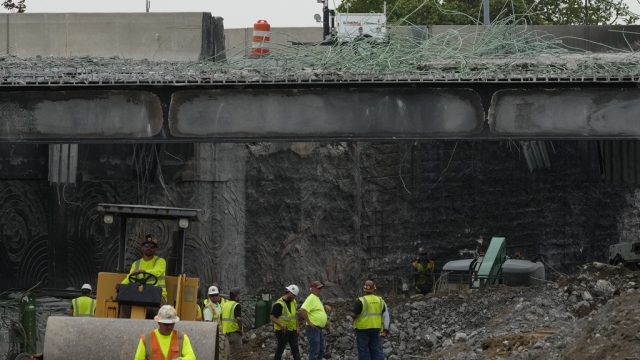The collapse of a portion of Interstate 95 in Philadelphia has transportation officials concerned that the prices of some goods could go up, as truck drivers are delayed or forced to find alternate routes to avoid the heavily traveled section of roadway.
The bridge collapsed on June 11 after a tanker truck carrying gasoline hit the bridge supports and exploded into flames.
Since then, crews have been working around the clock to get the bridge rebuilt, and the U.S. Department of Transportation's Federal Highway Administration is pouring $3 million in emergency funds into the project.
The president of the Pennsylvania Motor Truck Association, Rebecca Oyler, thought about American goods first.
"When you have a disruption like this there definitely will be impacts on the supply chain, both locally and nationally," Oyler said.
An estimated 150,000 vehicles typically use the damaged section of I-95 every day.
According to transportation officials, 8% of those vehicles are trucks, carrying products to all corners of the U.S.
Transportation Secretary Pete Buttigieg warned last week this disruption could drive up the cost of some goods.
"Part of what goes into the cost of what we see in the store is the cost of shipping," Buttigieg said.
But just how far-reaching can the effects of one bridge collapse be?
University of Minnesota Professor Karen Donohue offered a bit of insight. Donohue was just a few blocks away when the I-35W bridge in Minneapolis collapsed in 2007.
The NTSB says a design flaw caused that deadly collapse. It was closed for almost two years.
"If you talk to most Minnesotans who were around, they can recall where they were at the time that the bridge collapsed," Donohue said.
Years after the I-35W disaster, the Minnesota Department of Transportation released a study about the economic impacts of the bridge being closed.
In 2007, the state lost about $17 million because the highway was closed. In 2008, the state's economy took a $43 million hit, losing an estimated $400,000 a day.
There have been other bridge collapses that have economic ripple effects, too.
In Washington state when the Skagit River Bridge collapsed, state officials at the time said the closure of that highway would result in $47 million in lost economic output.
The impacts of both events lasted for years.
"This ripple effect can influence an area for not just the time it takes to rebuild but afterward. As folks have figured out other routes, they've figured out other places to shop," Donohue said.
In Philadelphia, officials say it's too early to tell just how much this collapse will cost the economy.
But history, freight experts say, is part of the reason why officials here are so eager to get this bridge back open.
Trending stories at Scrippsnews.com




